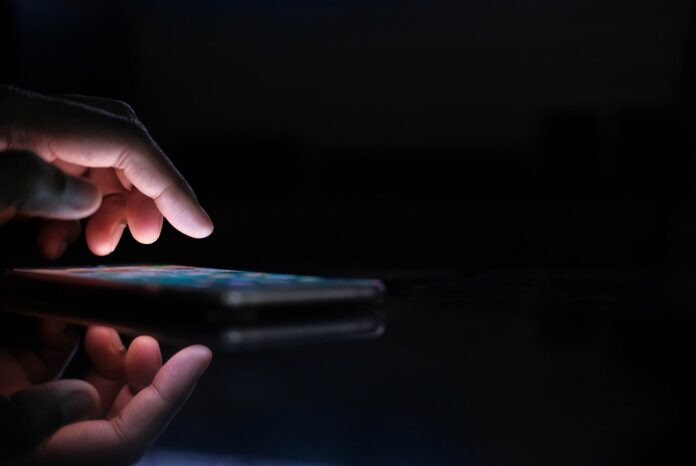Sleep is essential for maintaining our physical and mental well-being. Without getting an adequate night’s sleep, the following day might seem like we’re living in a shadow. Can using night mode on screens help you sleep better?
A new study published by scientists from the Centre for Chronobiology of the University of Basel and the TUM says that Light color is less significant than previously considered for the internal clock.
Vision is a difficult process. A mixture of various wavelengths of light creates visual perception of the surroundings, which is processed as colors and brightness in the brain.
Light is initially converted into electrical impulses by photoreceptors in the retina; given enough light, the cones permit crisp, detailed, and colored vision.
Rods only help eyesight in low-light circumstances, enabling various shades of grey to be identified but leaving vision significantly less accurate.
Finally, electrical nerve impulses are sent to ganglion cells in the retina and subsequently to the visual cortex in the brain via the optic nerve. This part of the brain converts neural activity into a colored picture.
What factors impact the internal clock?
Ambient light serves not only the purpose of vision but also plays a crucial role in influencing our sleep-wake cycle. Specialized ganglion cells play a significant role in this influence, similar to cones and rods, as they are sensitive to light, particularly responding strongly to short-wavelength light at approximately 490 nanometers.
When light consists mainly of short wavelengths ranging from 440 to 490 nanometers, we perceive it as blue. If these short-wavelength lights activate ganglion cells, they send signals to the internal clock, indicating it is daytime.
The critical aspect is the intensity of the light per wavelength, while the perceived color is not a decisive factor.
However, the light-sensitive ganglion cells also receive input from the cones, prompting the question of whether cones, and consequently light color, also affect the internal clock.
Dr. Christine Blume, leading research at the Centre for Chronobiology at the University of Basel, delves into the impact of light on human beings and is the primary author of a study exploring how different light colors influence the internal clock and sleep.
The findings of the study were published in the scientific journal “Nature Human Behaviour.”
Comparing the Impact of Light Colors
Christine Blume notes, “A study in mice in 2019 suggested that yellowish light has a stronger influence on the internal clock than blueish light.”
In humans, the primary influence of light on the internal clock and sleep likely occurs through light-sensitive ganglion cells.
“However, there is reason to believe that the colour of light, which is encoded by the cones, could also be relevant for the internal clock.”
To investigate this, the team exposed 16 healthy volunteers to either a blueish or yellowish light stimulus for an hour in the late evening, alongside a white light stimulus for control.
The light stimuli were carefully designed to selectively activate color-sensitive cones in the retina, with consistent stimulation of light-sensitive ganglion cells across all conditions. Any differences in light effects could thus be directly attributed to the specific cone stimulation and, ultimately, the color of the light.
Manuel Spitschan, Professor of Chronobiology and Health at the Technical University of Munich, involved in the study, explains, “This method of light stimulation allows us to separate the light properties that may play a role in how light effects humans in a clean experimental way.”
To understand the effects of various light stimuli on the body, the researchers, in a sleep laboratory, assessed whether the participants’ internal clocks changed based on the light color.
They also measured how quickly volunteers fell asleep, the depth of their initial sleep, inquired about their tiredness, and tested their reaction times, which diminish with increasing sleepiness.
The findings
The findings led to a clear conclusion: “We found no evidence that the variation of light colour along a blue-yellow dimension plays a relevant role for the human internal clock or sleep,” states Christine Blume.
This contradicts the outcomes of the aforementioned mouse study.
She adds, “Rather, our results support the findings of many other studies that the light-sensitive ganglion cells are most important for the human internal clock.”
Manuel Spitschan views this study as a pivotal stride in translating fundamental research into practical applications: “Our findings show that it is probably most important to take into account the effect of light on the light-sensitive ganglion cells when planning and designing lighting. The cones and therefore the colour play a very subordinate role.”
Whether the color of light remains inconsequential to sleep under different circumstances, such as extended light exposure duration or varying timings, remains an open question. Subsequent studies are warranted to address such inquiries.
Effectiveness of Night Mode on Screens: A Worthwhile Feature?
We often read that the short-wavelength component of light emitted by smartphone and tablet displays has an impact on biological rhythms and sleep.
The advice often given is to stow away your mobile device early in the evening or, at the very least, activate the night shift mode, which diminishes the short-wavelength light and imparts a slightly yellowish tint.
Christine Blume corroborates this recommendation. However, she points out that the yellowish color adjustment is an incidental outcome that could be avoided.
According to the sleep researcher, “Technologically, it is possible to reduce the short-wavelength proportions even without colour adjustment of the display, however, this has not yet been implemented in commercial mobile phone displays.”
Image Credit: iStock
